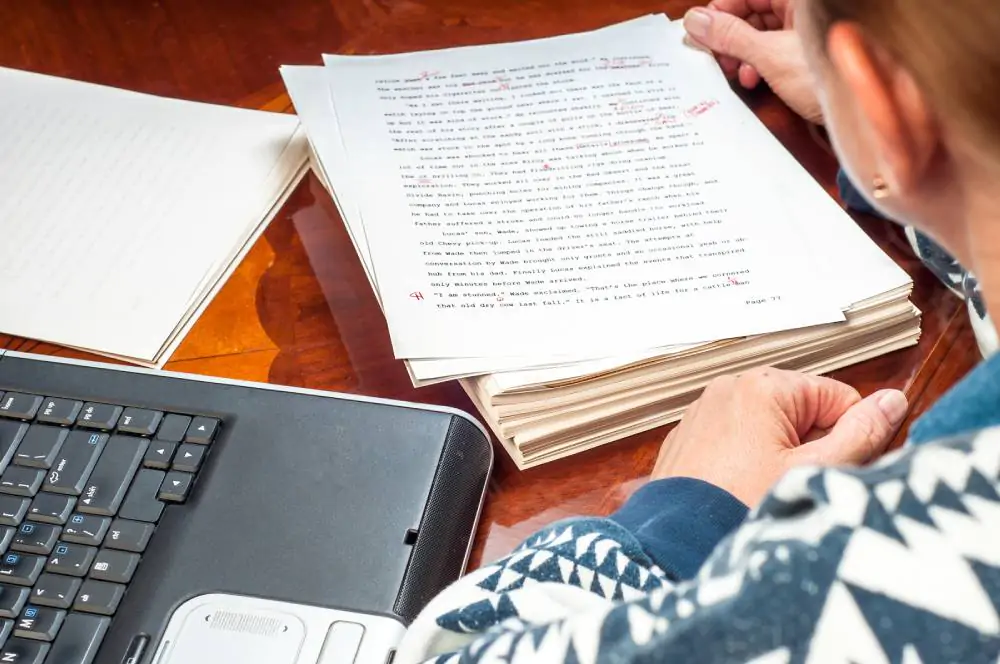Editing is a vital part of news publication if you are wondering, “what is editing in journalism?” Read on to discover our comprehensive guide on this topic.
Editing in journalism is when an individual assesses a piece of content and makes the necessary changes, ensuring the content is of the required standard. It is a complex process involving the assessment of news stories by an individual or team of individuals who did not write the story.
These individuals, known as editors, look for issues around spelling, grammar, and fact-checking and examine the readability of the content they are editing. A news editor may also have to condense a reporter’s story for economy of space reasons.
Below, we look at the different types of editors you will find in newsrooms within the industry. This is not an exhaustive list of the different types of editors, as new roles in this sphere are always appearing within news organizations.
Contents
Why Editing Is Essential

Editors may have to change the format of the piece if the reporter has buried the lede. This means that the writer has opened with a subject matter that is not interesting and hidden the most important pieces of information further down within the article. Editing in news writing ensures that the grammar and syntax of an article are up to standard before publishing. There are different types of editing styles, such as proofreading, formatting, and page layout. These editing styles are essential for publishing a professional news item for public consumption.
You might find our round-up of the best investigative journalism books helpful.
Editorial Assistant
Typically, an editorial assistant is a junior job. An editorial assistant will typically brainstorm ideas, proofread the content, and do administrative and editorial tasks. Assistants play a vital role in the writing process and provide much-needed support to their senior editors to ensure smooth running of the publication process.
Sub-editor
Newspapers and magazines often have sub-editors that take the raw copy from writers and prep it for publication. Their job is essential, as it involves spotting errors in layout and grammar while also fact-checking. They design the page for publication, ensuring that the articles fit as they should and cut them where necessary. A sub-editor is often responsible for the headlines that go along with the articles within daily newspapers and magazines. These editors are a valued commodity, often with design and copyediting skills.
To let you know just how difficult this job can be, Allan Chekwech, the Chief Sub Editor of Daily Monitor newspaper, says that his job is “high-stress and looks like a daily examination.” Some news organizations have chief sub-editors. As the title suggests, these people manage a team of sub-editors and copyeditors.
However, more and more newsrooms are moving away from this editing process. This is particularly true within online media, where journalists are expected to complete the writing process, add images, and ensure the content is in the house style and that the page layout is as it should be.
Commissioning Editor
Commissioning editors are typically more common in magazine publishing houses, but some newspapers employ them to deal with freelancers. These people manage external contributions to the publication. It is their job to ensure that these contributions are of the quality required and that writers are correctly briefed on the requirements.
A commissioning editor will also have to go through submissions and find the pieces that are the best fit for their publication. For this job, you must have excellent news sense and an ability to spot good writing.
Section Editors
Newsrooms typically have different section editors for different parts of the publication or website. For instance, there could be an entertainment editor, a sports editor, a features editor, and a news editor. These editors will typically focus on their specialty, assigning writers to take on stories within that area and editing that writing. Then, they set the overall plan for their section. They also make key decisions regarding the copy and format of the stories within their assigned section.
Typically, this is a management role. When that job arises, a section editor is typically well placed to become the overall editor of a publication. That is because they have experience making the key decisions for their section, a skill they can expand on when making the next step in their career.
Web Editor

As web publications become increasingly popular, so does the need for web editors. A web editor’s role is similar to that of a section editor, except they will often have duties exclusive to online. These can include optimizing the story for search engines, monitoring comments on the story, and ensuring that all facts are up-to-date as a story evolves.
Web editors usually update their stories on current events as new information comes to light. In contrast, newspaper editors have to collate the information at hand at a given deadline for publication.
Deputy Editor
The deputy editor is the editor-in-chief’s right-hand person. Usually, they are there to ensure that the workload doesn’t become too much for the editor. When the editor is absent, the deputy editor steps in and does their job. Sometimes people within this role are known as assistant editors. This news editor is often the person in the room helping the editor make key decisions.
Editor & Editor-in-chief
The editor, sometimes called the editor-in-chief, oversees what goes on within a publication. This person manages all of the other editors and sets the overall message and standard of the publication. They also act as a gatekeeper for content, ensuring that everything that goes within their publication is of a certain quality. In addition, the news editor makes key decisions, including what goes on the front page, the house style for a publication, and which pieces of writing gain prominence within their publication. A good editor will work with his team of writers, sub-editors, and section editors to create a consistent tone of voice across a publication. Below, we examine further what makes a good editor.
What Makes A Good Editor
Editing in journalism is so varied that it is almost impossible to go through all the skills needed to do the job well. However, there are a few apparent characteristics that all of the best editors have.
Read on to see the top qualities that make a good editor in any news publication team:
Leadership Qualities
The nature of journalism means that there will be times when a publication will face conflict and difficulty. It is during these times when the leadership qualities of a good editor come to the fore. This can be when something goes wrong or simply as part of an investigation where reporters are trying to keep those within power accountable. The editor is the ship’s captain, and their crewmates (the writers and reporters) need to feel like the editor has their back. When they feel this way, they are empowered to do their best work as reporters.
Examples of this are plentiful, but one that sticks out is Walter ‘Robby’ Robinson. He led a team of reporters at the Boston Globe to expose issues within the Catholic Church as part of an investigation that would later inspire the Spotlight movie. Of course, there were plenty of issues along the way. However, Robinson’s leadership qualities helped the team uncover one of our time’s biggest and most important news stories.
Attention To Detail
Editors on every level need to have excellent attention to detail. If they don’t, then their publications will be full of grammatical errors, have a questionable relationship with the truth, and will, in all likelihood, fail.
A good editor is a gatekeeper for content and knows how to ensure that the different writing styles of reporters can all go into the same publication. They do this by implementing a strong house style that conforms with their standards. If you are looking for an example of a house style, the associated press’ style guide is one of the most popular.
Strong News Sense
In many newsrooms, the day begins with editorial meetings, where reporters detail the stories they are working on. The editor will also have a calendar with potential events that need to be covered. In this instance, a good editor will help their newsroom prioritize the most exciting stories for their audience. Then, they will set out their resources and try to ensure that reporters cover all of the most important stories.
As Peter Cole from The Guardian pointed out, it is the editor’s job to know what their readership wants and to help get that information to them. Mr. Cole wrote: “The good newspaper editor will have a clear idea of the sort of people who are reading it, and cater to their interests and preoccupations, sometimes their prejudices. And the paper will include that vital ingredient serendipity – the story you didn’t expect, the “just fancy that” the absurdities and the travails of the human condition.”
Excellent Writing Skills
Last but not least, an editor must have excellent writing skills. There are many reasons for this, one of them being that this helps them format articles that need editing. Another reason is that this allows them to do the challenging work of rewriting convincingly. Lastly, editors set the sentiment of the publication with their editorials. When these editorials are written well, they become a voice for the news organization.
Resources For Journalists
What Is An Inverted Pyramid in Journalism
11 Best Journalism Tools For Busy Professionals
What Is Muckraking Journalism?
What Is Watchdog Journalism? A Helpful Guide
What Is Science Journalism? A Detailed Guide
10 Best Tools for Data Journalism For Research and Data Management
Best 7 Journalism Skills To Make You a Successful Journalist
5 W’s of Journalism: Everything You Need To Know
What Is Gonzo Journalism? Explained
FAQs About What is Editing in Journalism
What is the difference between editing and proofreading?
Proofreading is checking an article for grammar errors. However, editing involves fact-checking, looking for grammatical errors, and ensuring the piece is written in the right format. With editing, there may be no issue with the grammar of the piece, but there might be an economy of space where it needs to have a certain amount of words removed. Editing is a much more complex action than proofreading is.
Looking for more on this topic? Check out our guide on “Is Journalism A Good Career?”